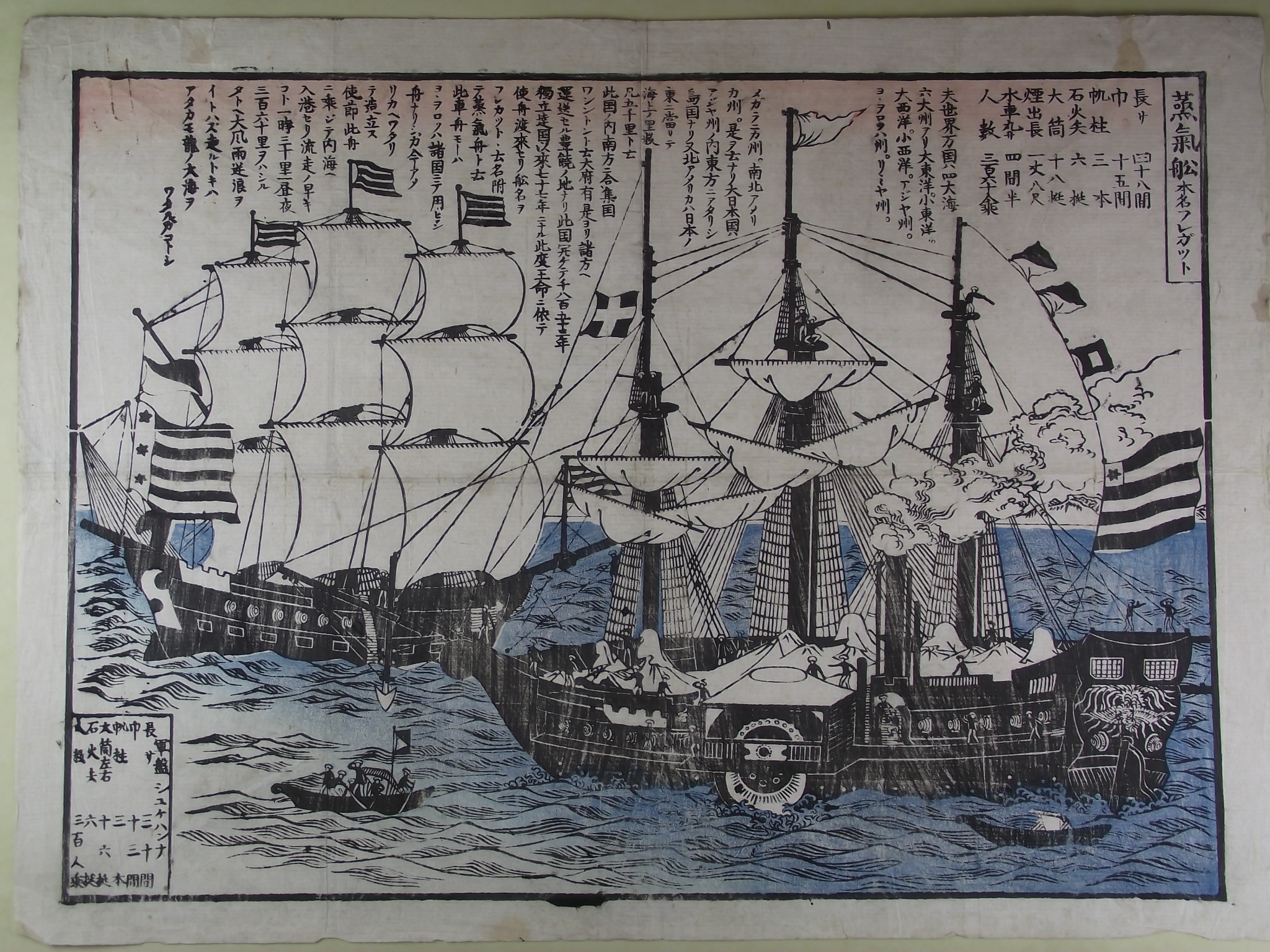I am ashamed to say that though I grew up in the Hampton Roads area, I had not visited the Mariner’s Museum until this past spring. I am not terribly interested in boats or maritime equipment, and so always assumed that there would be nothing of interest for me at the Museum. I could not have been more wrong. Aside from the beautiful ship models of all shapes and sizes, the Museum has all sorts of maritime paraphernalia, from old compasses and teapots to uniforms and interactive exhibits. What I was most surprised and excited about, however, was the Museum’s Asian print collection. Hidden away in storage lies about 100 Asian prints, mostly Japanese, dating from the 19th to the 20th centuries. Though the prints are all connected by a reference to maritime themes, they often vary widely in content. From illustrations of Commodore Matthew Perry, who was the first American to enter Japan in the 1850’s, to descriptions about foreign ships and vibrantly colored pictures of everyday Japanese life, the Mariner’s Museum’s prints give the viewer a glimpse into Japanese history from their perspectives, as well as providing visually appealing pieces of art.
Perhaps the most historically interesting pieces in the print collection are the Japanese prints concerning the arrival of Commodore Perry between 1852 and 1854. Perry’s arrival signaled an end to Japan’s long period of self-imposed isolation, and the technology he brought with him, as well as Western clothing and cultural customs, were new to the Japanese, fostering much interest among them. In order to document these new sights, as well as explain them to the general public, Japanese prints such as the one below were created.

This print, circa 1854, pictures two vessels in Perry’s fleet. The paddle-wheel ships were unlike any vessels the Japanese had seen before, and some of the text above the ships explains the different parts of the ship, how fast it goes, and where it was originally invented (Europe). The text also explains for its viewers that these ships came from a place called North America, which has a large city called Washington. The text also states that “the country is very rich and fertile with convenient means of transportation to all parts of the world.”
In addition to describing Perry’s ships, the collection also has prints that describe the foreigners who arrived on these ships. Different in physical appearance and dress from the native Japanese, these foreigners often baffled and scared the Japanese population, who had been without contact with the outside world for 200 years. To help with the confusion, prints were made and distributed that explained the different foreigners Japanese people might encounter:

This print depicts and explains nine types of foreigners who came with Perry; the portraits include Perry himself, Naval and Marine officers, a seaman, a musician, an interpreter Marine, and a black man. On the bottom left is their ship, the USS Susquehanna. This print functioned at the time as a utilitarian print, educating the public about the new arrivals. Today, this print teaches us about how the Japanese saw the American foreigners; the figures and ship have frightening, unhappy faces, showing that the Japanese found these new people a bit scary and strange.
Nowhere is this clearer than in this print of Captain Adams, Perry’s second-in-command, which depicts him as having a giant nose, giant ears, and a strange, frowning mouth.

Despite the advent of foreigners, however, everyday life and art went on. At the time of the Perry Expedition, Japanese woodblock prints were famous for what was known as the Ukiyo-e, or floating world, style. Ukiyo-e prints were brightly colored, popular prints depicting scenes from everyday life such as a fisherman charring the bottom of his boat to make it seaworthy.

This print has all the quintessential characteristics of an Ukiyo-e print: bright colors, interesting pattern (in the man’s clothes) and a scene from everyday life. Other Ukiyo-e prints in the Museum’s collection have similar themes featuring boats, some of which are by quite famous Japanese print artists of the time. The two prints below are by Hiroshige, a prominent Ukiyo-e artist.


These prints also feature boats and bright colors. Another Japanese print in the collection, which is highly recognizable, is called The Great Wave, from 36 Views of Mt. Fuji by Hokusai.

A reproduction of this iconic print, done by one of the foremost Ukiyo-e masters, is set to join an upcoming exhibition at the Peninsula Fine Arts center, so stop by and have a look. Exquisitely crafted with vibrant colors and minute details, this print is not to be missed!
Finally, not all prints in the Museum’s collection are Japanese; the print below is of a very famous Korean admiral named Lee Soon-shin. The Admiral invented iron-clad ships called Turtle Boats, which helped save Korea from 16th century Japanese invasions. This print is quite rare and an important part of the Museum’s collection. Interestingly, for those of you who know anything about Korean dramas, a popular one named Gu Family Book just aired in South Korea, and one of its major plot points was the successful creation of Turtle Boats by Admiral Lee despite political intrigue.

This has been just a small sample of the Asian prints in the Museum’s collection. There are many more beautiful and historically important East Asian prints at the Museum, so if you are looking for something fun to do come explore the Museum or search the online database for more information.
To explore the museum’s collection of East Asian print, you can search through the collection online HERE or see what is available through photography on the image collection HERE. It is also possible to order copies of our prints through our photography department HERE. A lot of these prints, especially the more colorful ones, would make beautiful wall hangings.